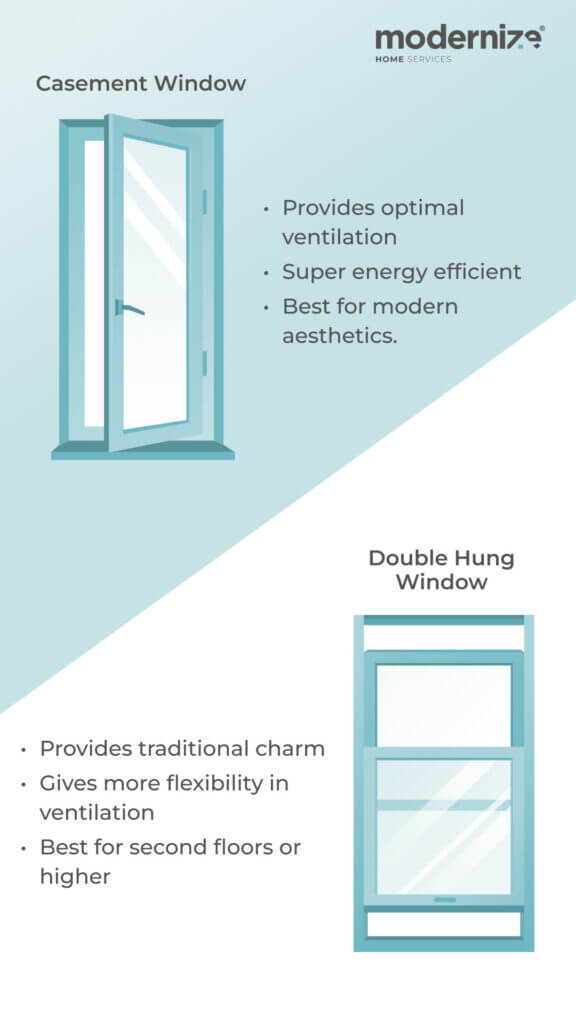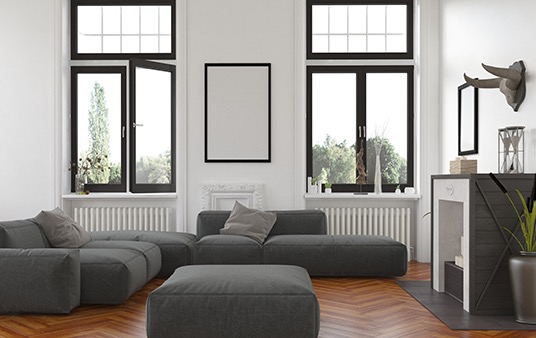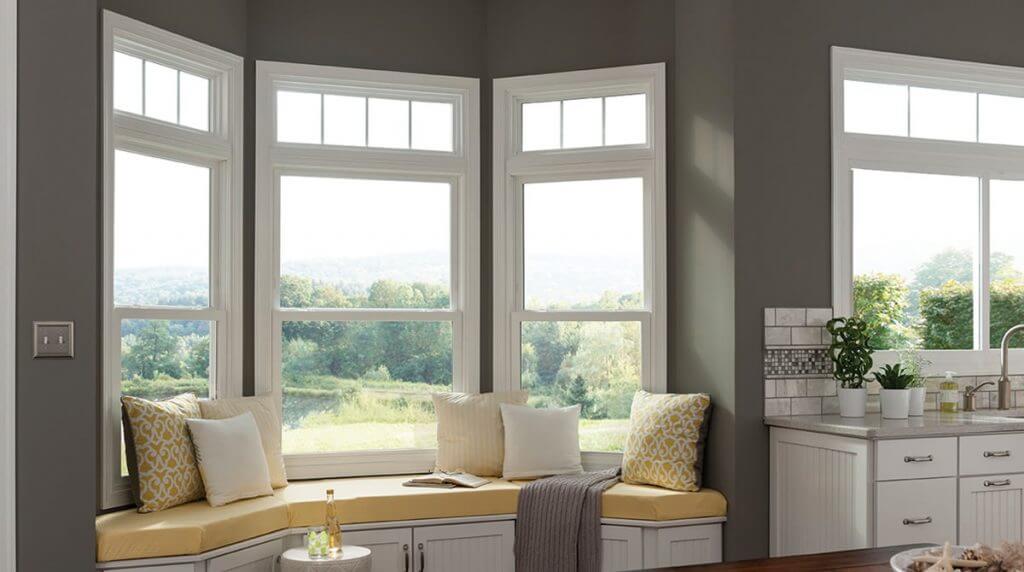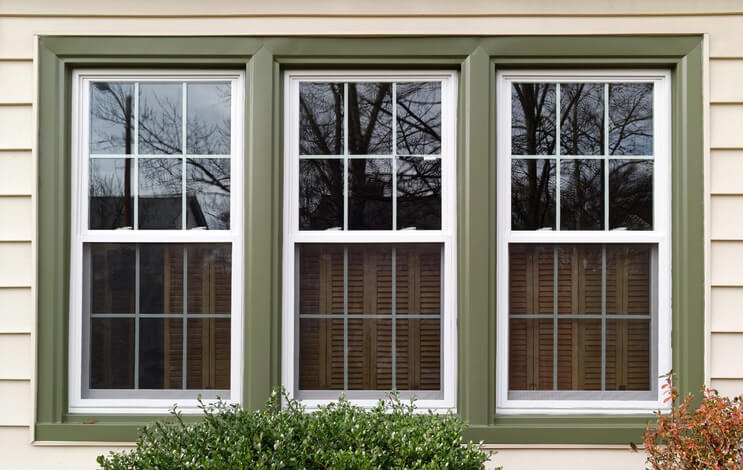Are you doing a windows project?
Modernize can pair you with three to four pros in your area, so you can compare options and save time and money.
Among the most popular choices when homeowners are replacing their home’s windows are casement windows and double-hung windows. Each style offers unique features and benefits, so the final choice between one or the other will ultimately come down to what you prioritize about how your home functions. In this guide, we will compare casement windows vs double-hung, highlighting their key features, pros and cons, and relevant differences to help you make an informed choice.

Casement Windows: Features, Pros, and Cons
Here’s the essential info about casement windows you should know.

Key Features
- Casement windows are hinged on the side and open outward, providing excellent ventilation and unobstructed views.
- They have a modern and sleek design, adding a touch of elegance to any home’s interior and exterior.
- Casement windows are available in various materials, such as wood, vinyl, aluminum, and fiberglass, providing homeowners with a wide range of window frame options to match their home’s architectural style.
Pros and Cons of Casement Windows
Pros:
- Energy efficient. When closed, casement windows create an airtight seal, reducing drafts and improving energy efficiency by preventing air leakage.
- Great ventilation. Casement windows can be opened fully, allowing for maximum airflow, making them ideal for areas where proper ventilation is crucial, such as kitchens and bathrooms.
- Unobstructed views. With no center mullion, casement windows offer an uninterrupted view of the outdoors, enhancing the aesthetic appeal of any living space.
- Easy to use. Casement windows are easy to operate, often featuring a crank or lever mechanism, making them accessible for all ages.
Cons:
- Need lots of exterior space. Casement windows swing outward, requiring clearance space outside the window. This can be a limitation for homes with limited outdoor space or areas close to walkways or landscaping.
- Screens are a challenge. Screens for casement windows can be tricky to install, and retractable screens may add to the overall cost.
- Difficult to install window AC units. If you rely on window air conditioning units to stay cool, casement windows are not for you. Units range from “difficult” to “impossible” to find and install.
Double-Hung Windows: Features, Pros, and Cons
Here are the “must know” facts about double hung windows.

Key Features
- Double-hung windows have two sashes that slide vertically, allowing for both top and bottom ventilation.
- They are available in various materials, including wood, vinyl, and fiberglass, offering different aesthetics and maintenance requirements.
- Some double-hung windows feature a tilt-in function, allowing for easy cleaning of both the interior and exterior glass surfaces.
Pros and Cons of Double-Hung Windows
Pros:
Find the Right Contractor for Your Windows Project
Whether you’re ready to begin your project now or need some expert advice, our network of contractors are here to help. With a few simple questions, we’ll find the best local professionals for you
- Flexible ventilation options. Double-hung windows offer flexibility in ventilation with the option to open either the top or bottom sash, making them suitable for various weather conditions and personal preferences.
- Fit in most spaces. Since double-hung windows open vertically, they do not require additional clearance space outside the window, making them ideal for areas with limited outdoor space. They also come in lots of sizes, so you can find one that will fit even smaller, narrower wall spaces.
- Easy to clean. Some double-hung windows feature a tilt-in function, allowing homeowners to clean both sides of the glass from the comfort of their home.
Cons:
- Can be drafty. Double-hung windows do not seal as tightly as casement windows, potentially leading to drafts and reduced energy efficiency. If you live in a climate with extreme temps in the winter or summer, you may want a window with a tighter seal.
- Obstructed views. The presence of a center mullion can obstruct the view, especially when only one sash is open. If you want the clarity of a picture window but with added functionality, a casement window is the better choice.
Key Differences Between Casement Windows vs Double-Hung
- Ventilation. Both window styles have excellent ventilation, but you may prefer one ventilation option over the other. Casement windows open fully, while double-hung windows provide flexibility by allowing both top and bottom sashes to open.
- Design and aesthetics. Casement windows lend themselves to a more modern home style, while double-hung windows are more traditional. You may find is better suited for your home’s architectural style.
- Energy efficiency. Casement windows have an edge in energy efficiency due to their airtight seal when closed, whereas double-hung windows may be more prone to air leakage.
- Cleaning and maintenance. Some double-hung windows come with a tilt-in feature, making cleaning easier, whereas casement windows require full opening to clean both sides.
- Space. Casement windows need clearance space outside the window for opening, while double-hung windows are a better fit for spaces with limited exterior clearance.
Cost Considerations
The cost difference between casement windows and double-hung windows can vary depending on factors such as materials, size, and features. Generally, casement windows cost more due to their enhanced energy efficiency and modern design. Double-hung windows cost less up front, but may not decrease your monthly energy bills like casement windows would.
The average cost for a standard sized casement window is $871 per window, while the average cost for a standard sized double-hung window is $608 per window.
So Which Window is Right for You?
Choosing between casement windows vs double-hung ultimately depends on your specific needs, preferences, and the architectural style of your home, but here’s our recommendation.
Choose a casement window if you prioritize:
- optimal ventilation.
- energy efficiency.
- a modern aesthetic.
Choose a double-hung window if you prioritize:
- traditional charm.
- easy cleaning.
- flexibility in ventilation.
Consult with a reputable window professional to assess your home’s requirements and explore the available options, ensuring that your final decision aligns with your budget as well as your home’s style and functionality.
Find the Right Contractor for Your Windows Project
Whether you’re ready to begin your project now or need some expert advice, our network of contractors are here to help. With a few simple questions, we’ll find the best local professionals for you
Reviews from Real Homeowners
Welcome to Homeowner Resources! We are the Modernize blog. Modernize pairs more than 3 million homeowners a year with pre-vetted contractors in their area. This blog started because we believe homeowners should know everything about their homes, from how their HVAC works to which front door colors they might love. On Homeowner Resources, you can find information on every part of your home, right down to how you can negotiate with contractors to get the best price. Here's more about the blog.
Need a contractor? Learn more about how Modernize finds the right pro for you.





